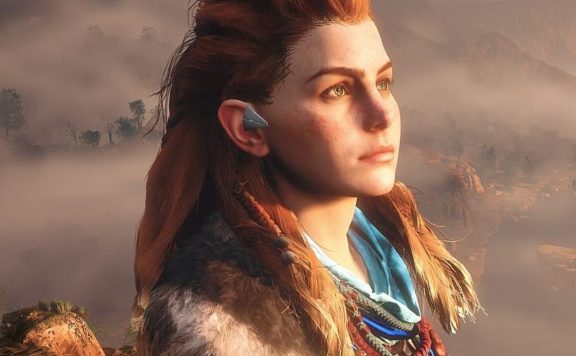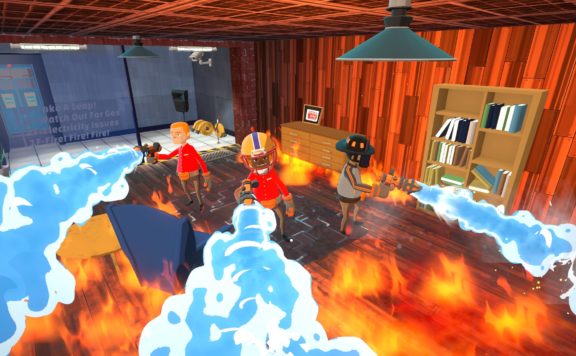Wayfinder just wrapped up a round of closed testing and we got hands on with Digital Extremes’ latest project. Suffice to say this isn’t what we were expecting at all.
Just a week or so ago, certain circles of social media found their interest piqued. A bright new contender stepped out of the shadows and into a brand-new world of adventure. Wayfinder took to the stage just ahead of an early round of testing. Touted by some of our peers as the best thing since Wildstar we managed to put down our stuffed Rowsdower long enough to go hands on with the latest title from Digital Extremes and see if it really was the second coming of the ‘greatest MMO of all time’.
Don’t Judge a Book
Wayfinders burst into our consciousness in March 2023 with a stunning trailer. Following the echoes of iconic heroes resurrected to defend a dying world, this upcoming title form Airship Syndicate looks stunning. The visual style takes has obvious parallels with a certain space faring MMROPG, Torchlight Infinite, Space Punks, and a plethora of other stylized RPG experiences. This time, the title tends to lean close to the Torchlight experience, mixing in muscle bound warriors animated against a range of gloomy dungeons, feudal far future townships still stand in the darkness with a sprinkle of magic and neon decorating them too. Even in the opening player hub of Skylight, there’s a definite nod to the mix of frontier settlements and high tech mysticism that Wildstar embodied. Here though, you’ll find intricately detailed taverns, workshops, waystations, shops, workshops, and more. All of these come to life in gorgeous DX11 or DX12, with denizens that might not mingle much but all have their own take on this frontier life. There’s a level of detail to the environment that’s kind of astonishing and sweeps the clean aesthetic of Genshin out the door for a more organic depiction of a town that’s stood the test of time and has a rustic charm to it.

Towering over the other side of this take on an Alliance Stronghold is a massive steeple. Simple in design but incredibly important, this is a nexus. It gives adventurers access to a number of missions, encounters, and dungeon runs. It is also the central focus for our gameplay, when you’re not off exploring lower Skylight and the open world areas of Wayfinder.
Character Creation
That same style and charm that makes Skylight so gorgeous, is draped all over the heroes that populate it. Character creation introduces a number of welcome twists to this tale. Each Echo of a fallen warrior is a wonderful cartoon depiction that mixes far future high-tech barbarians with nimble assassins. Rather than arcane mages, you can expect rifle wielding survivalists who have more in their utility belt than the Dark Knight might need. It’s, much like the rest of the game, a mix of contemporary influences and traditional fantasy ideas. Again, it is also something that might resonate with fans of a certain retired NCSoft MMO, but the differences are very obvious. Don’t expect to log into Wayfinder and find a set of traditional class archetypes. Like many online RPGs, Wayfinder recruits characters with their own playstyle and history. If you’ve logged into Warframe, Tower of Fantasy, or even Torchlight Infinite then this might feel familiar. While the axe wielding Senja and quick footed Niss might be mistaken for tank and rogue, but the most obvious early deviation comes in the form of Wingrave. This sword and board hero might be armored up to the hilt but it turns out this tank is more of a combat medic, casting out heals while engaged in melee combat. Throwing out the traditional ranged DPS and mages might just be a temporary decision, but filling the space with flexible and interesting ideas is a difficult task that we will get to shortly.

Each of these individuals wade into battle using a standard control system. The third person camera gives a solid view of what’s coming up and the movement mechanics will be recognizable to anybody who’s played a modern ARPG or MMO. Once again, that familiar comparison creeps into view. A third person camera, double jumps, dodge rolls, and a mouse and keyboard combo that comes tied together by a limited action set. Even the pace of combat and character movement feels subtly similar. However, RPG controls aren’t exactly an innovation that unique to one IP. You could just as easily make the comparison to Paladins, and the great thing about this is that it makes the game intuitive from the off. While touring Skylight is simple enough, combat is little more nuanced. As I’ve described, a limited set of active skills accompany a block and primary attack. These skills provide an initial direction for class mechanics, offering attack boosts, buffs to allies, healing protection, and more. There’s likely to be plenty of tweaking to do, so it’s only really appropriate to say that they seem to lean in towards helping players understand how to handle a particular character before you really start to tweak the playstyle.
Movement is melded into an action combat control set that feels responsive but maybe doesn’t push itself to the same extremities that Warframe does. What does stand out here is the use of a Stamina, latent power, and break bar. Block is great but players will notice that there’s something of a risk reward for using it. Wingrave, for example, can weather incoming attacks but this depletes that break bar, which in turn offers up the opportunity to exploit other damage effects after taking a pummelling. While the option to dodge incoming attacks might eat up stamina, standing your ground also builds up Latent power, eventually popping off a very powerful ability. It leads to a playstyle that can have nuance but follows a particular form.
Battling Beyond The Highlands
Combat, of course, is key to this experience across the game’s core modes. These are generally the open world experiences and dungeon runs. The Highlands are laid out in the trailer above and represent the open world areas of Wayfinder. These lush green hills are backed by gravity defying rings, unusual stone architecture and plants that certainly don’t look like your average shrubbery. While seeming sufficiently alien, this early open world is still rocking a starter zone aesthetic. Quests, mobs and the odd fetch quest won’t surprise anybody. While the room for exploration here is admittedly limited, it’s difficult to judge this when my day-to-day online RPG is as massive as Guild Wars 2. What I did love about this location is the potential for large and spontaneous encounters. The Highlands affords the opportunity to engage in dynamic encounters where hordes of enemies or large battles kick off. You’ll catch a glimpse of that in the preview trailers. Let’s be clear, Wayfinder doesn’t seem like it will develop a massive contiguous open environment with small encampments dotted across it. Instead, these Overlands play host to world bosses and less structured content that make the world feel lvied in. However, there’s another very important element to the core gameplay loop. The Gloom Gate.

A dungeon portal by any other name, the Gloom Gate is the poral to Wayfinder’s core instanced encounters. These Lost Zones were consumed by the faceless Gloom, and they act as endless instanced content and the title’s core content arena. Where open world area’s provide time to explore, kick back, and hopefully engage in unexpected events, these are far more regimented. Expeditions through this portal provide the opportunity to explore the impact of the Gloom in a more linear fashion than the Overlands, and grind for a ton of loot. While loot can come in many forms, there is no denying that this area of Wayfinder is far more like a traditional dungeon crawler than Wildstar’s raiding system. Sure, dungeons exist in both games and a heroic version of these randomly generated encounters will make for challenging content but Digital Extreme’s newest adventure is a more focused experience.

Each time we jumped into the Gloom we could head in solo or with a group. No thirty person raids quite yet, although there has been some discussion of these in the long term. Each encounter could be a cavern, castles, hive, or other abandoned areas full of twisted monsters and undead entities. There’s lots of quests, carnage, the odd puzzle, and tons of loot. This method of consuming content should allow for plenty of audacious ideas to be played out. Dungeons we tried were not particularly intense and didn’t take more than 15 minutes to beat at a slow pace. Like many other similar titles, that trudge of navigating trash and taking down a boss battle, can be rerun in various ways. What makes this repeating cycle of pick up and play content interesting is the option to add a whole range of modifiers, before and during the dungeon run. Several types of modifiers can mutate a run, each of which have their own difficulty level. More floral look or a colder reception and allowing players to elevate the difficulty and swap up encounters. This is a nice idea, and while the impact of these modifiers and the scaling of encounters is something I can’t definitively speak to this early on, it’s likely to make the ongoing grind a lot less tiresome.

Loot Gear and Progression
After a few dungeons runs, it is simple to see that progression is nothing like a normal MMO either. Much of Wildstar’s progression system fell into a formulaic vertical treadmill. This was a raiding system for the 1% after all. The core of the Wayfinder progression system is tied to modifying gear rather than simply grinding your way up the ladder or ditching the old stuff once you bash new greaves out of a boss. While a levelling system exists, it is generous and fairly uninvolved. Most of a character’s core competencies are unlocked early, and perks are slotted into gear and characters loadouts. These upgrades and tweaks are known as Echoes. They are largely looted from mobs and bosses, varying in rarity but utilized in the same way as upgrades might be viewed. Leveling individual characters seems to unlock more room to slot new upgrades, while swapping to a new weapon can utterly change how these choices impact gameplay. Wayfinder definitely seems to pick more ARPG progression systems more than your run of the mill MMORPGs.
Don’ Be Such A Rowsdower
So no, Wayfinders is not the next Wildstar. It’s all the better for it too. It might use familiar visual cues, but the world building benefits hugely from more modern systems. It treads closer to a wonderfully imagined fantasy that just happens in a galaxy far far away. The character recruitment and class system borrow more from the Warframe and Genshin than any MMO I’ve played, and progression feels far less punishing. Combat might not be a million miles away from what Wildstar fans want back, but Wayfinder has its very own distinct set of features you’ll need to learn to use. This isn’t the return of Wildstar, It’s a whole new adventure. There’s still tons more to learn about Wayfinder and loads of time left to explore its potential. For now, our brief weekend in this upcoming online adventure tells me I’ll be back for more when the next beta comes around. Find out more about Wayfinder over on the official website now.







